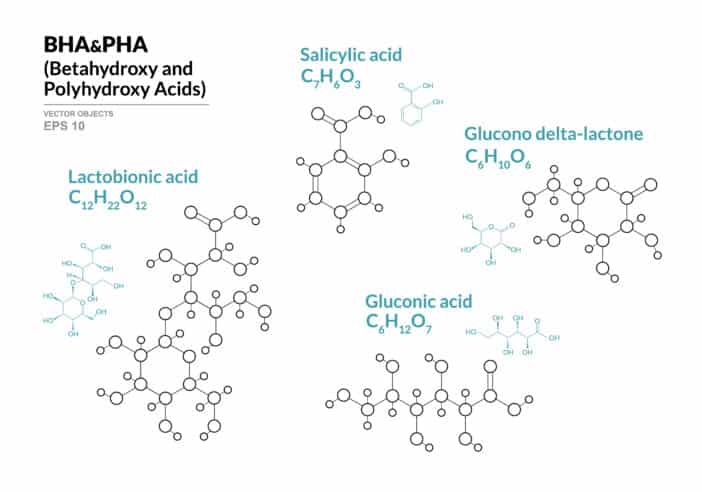Polyhydroxy acid

Polyhydroxy acid – the most important facts at a glance
Polyhydroxy acid is an excellent antioxidant and protects the skin from free radicals. It also has an antibacterial and anti-inflammatory effect. Normally, some unpleasant side effects occur after exfoliation. This can be a tingling or burning sensation on the skin, but sometimes there is also severe redness. With a peeling with polyhydroxy acid there are no such “side effects”.
In addition, a PHA peel does not dry out the skin as much because the active ingredient has a hydrating effect.
A treatment with polyhydroxy acid stimulates skin renewal. Acne scars, pigment spots and small wrinkles can often be reduced well with consistent and regular use.
Lactobionic acid: properties and effect
The term polyhydroxy acid actually describes an entire group of active ingredients, which are divided into lactobionic acid and gluconolactone. In principle, both substances are suitable for peeling. However, they have partly different effects. Lactobionic acid is particularly recommended for sun-related skin damage and for the prevention of signs of ageing, as it has a strong antioxidant effect. Its anti-ageing effect is extremely high. After application, it forms a thin film on the skin, as it can hardly penetrate the skin due to its relatively high molecular weight. By the way, sensitive skin particularly benefits from this extremely gentle and slow absorption. In addition, polyhydroxy acid has the ability to bind a lot of water. For this reason – and because of its strong antioxidant effect – it is often used in organ transplants to reliably protect the organs that are to be transplanted. As the name suggests, it is extracted from the lactose in milk. Polyhydroxy acid is a disaccharide and is formed by linking the polyhydroxy carboxylic acid gluconic acid with the sugar molecule galactose.
Gluconolactone: Description and advantages
Gluconolactone, on the other hand, is primarily capable of strengthening the skin’s protective barrier and thus making it more resistant to external influences. It also has the ability to reduce irritation and redness. In a study with more than 100 participants, it could be proven that a glutonolactone solution with a concentration of 14 percent is just as effective for acne (mild to moderate degree) as a five percent benzoyl peroxide solution. A peel with the polyhydroxy acid gluconolactone exfoliates the skin in a decidedly gentle and mild, yet highly effective manner. When applied to the skin, it alters the cornification process and promotes desquamation. The substance is also used as a food additive without a maximum limit ( E575) and occurs naturally in a few foods such as honey. However, the amounts are rather small.
Fact Sheet Lactobionic Acid
INCI: Lactobionic Acid
CAS number: 96-82-2
EC number: 202-538-3
Alternative name: Galactosylgluconic acid
Description: Polyhydroxy acid occurs as a water-soluble white powder.
Definition: The disaccharide is formed from galactose and gluconic acid.
Molecular formula: C12H22O12
Effect: strongly hygroscopic (water-binding), antioxidant, very good anti-aging effect
Fact Sheet Gluconolactone
INCI: Glucono-delta-lactone
CAS number: 90-80-2
Alternative names: E575, gluconic acid-1,5-lactone
Description: a sweet-tasting and colourless solid
Definition: an organic acid classified as a polyhydroxy acid
Molecular formula: C6H10O6
Melting point: from 156 to 162 degrees Celsius decomposition
Effect: moisturising and strongly hygroscopic long-term effect, stimulates skin renewal, promotes desquamation, strengthens the skin barrier, antioxidant
Fact Sheet Maltobionic Acid
INCI: Maltobionic Acid
CAS number: 534-42-9
Molecular formula: C12H22O12
Molecular weight: 358.3 g/mol
Definition: Maltobionic acid is the oxidation product of maltose and is described as a naturally derived anti-aging polyhydroxybionic acid.
Action: highly antioxidant and moisturising, gives suppleness to the skin, plumps up skin layers, reduces wrinkles and lines. Ideal for the care of particularly stressed skin areas on elbows, heels, and knees.
Polyhydroxy acid as an innovative active ingredient for gentle skin care
Because polyhydroxy acid has larger molecules than, for example, alpha-hydroxycarboxylic acids, it does not irritate the skin as much and is therefore ideal for sensitive and delicate skin. It can even be used for neurodermatitis and rosacea. In addition to the exfoliating effect, polyhydroxy acid has valuable moisturising properties thanks to its special ability to bind water. In view of all these aspects, polyhydroxy acid is a very interesting and important active ingredient in the formulation of sophisticated premium cosmetics with anti-ageing or peeling effects. Cosmacon is happy to develop modern and innovative formulations for you.